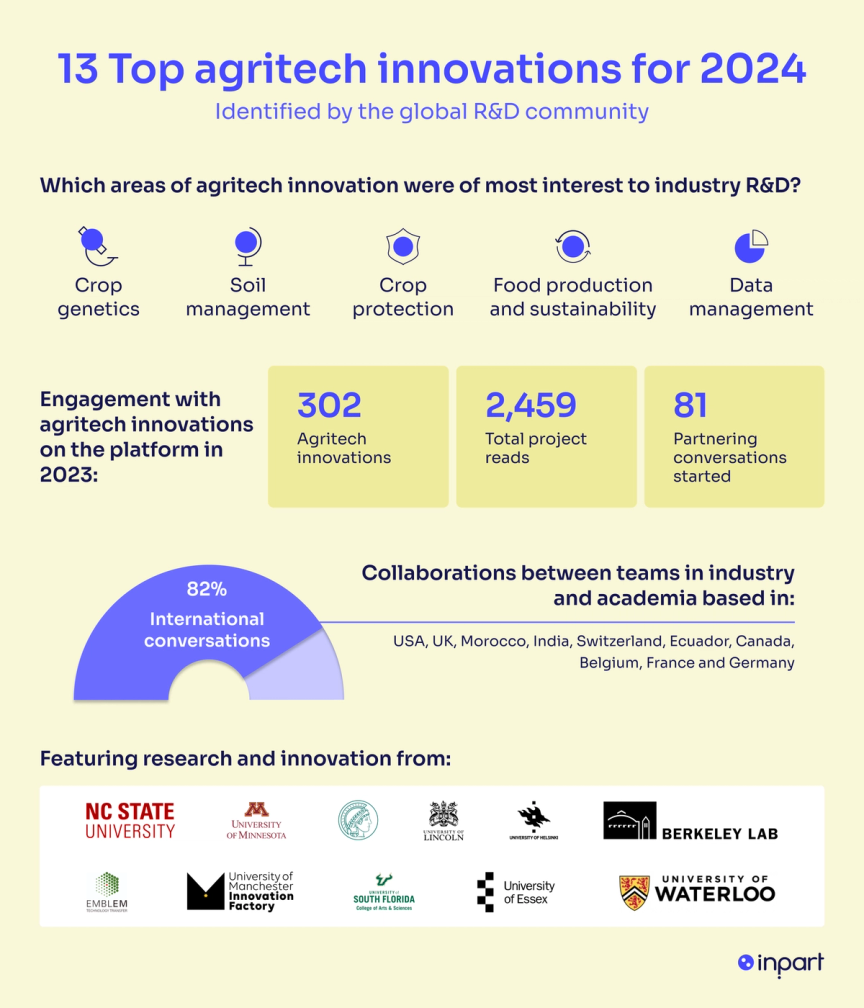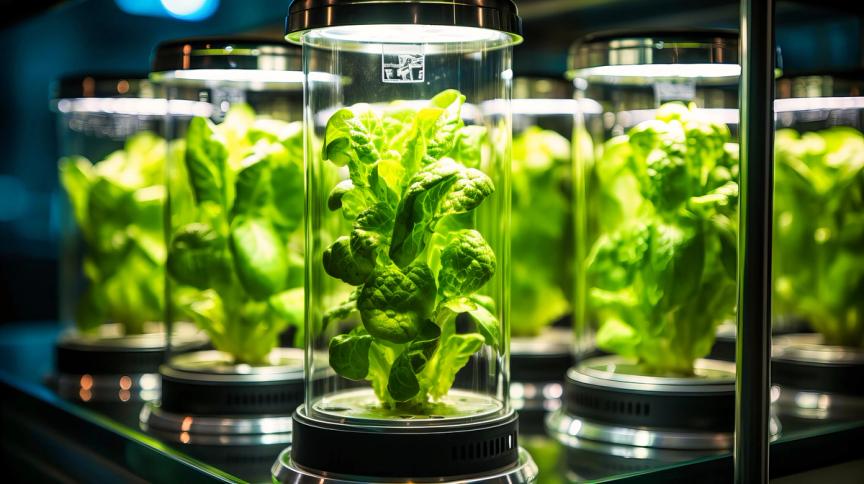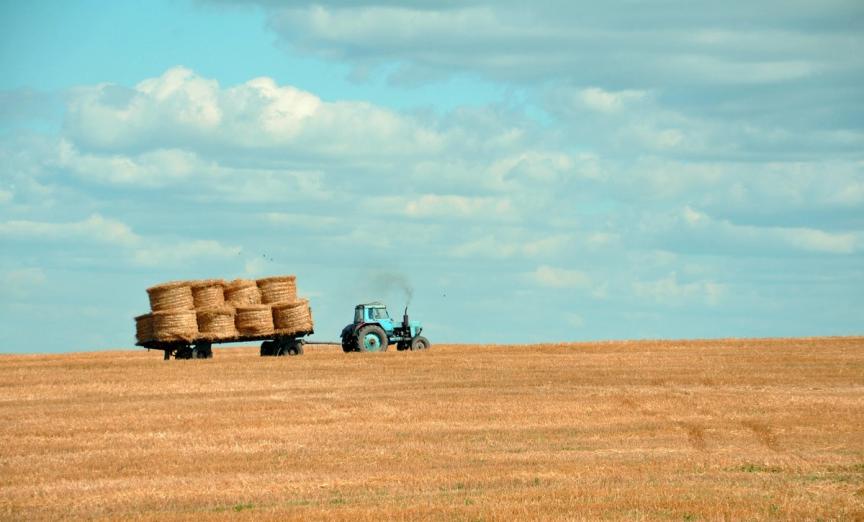To meet the demands of feeding growing global populations, research in agriculture is crucial to optimize the renewable use of natural resources, improve crop yields, and minimize ecosystem impacts. It’s estimated that food production will need to increase by 70% by 2050 to meet world hunger. Traditional farming methods alone will struggle to achieve this. ‘Agritech’, the deployment of technology, innovations and scientific thinking in agriculture to enhance productivity, is part of the solution that will help scale-up food production sustainably.
In this article, we’ve listed the 13 top agritech innovations published on our online academia-industry partnering network, Connect, by academic teams seeking to progress their research. It contains early-stage research projects, assets, and technologies that received the most engagement from the global R&D community actively using our network to identify new discoveries for their pipelines.
Our industry network contains R&D and external innovation teams in over 6,500 companies, including many key players in agriculture and food production such as BASF, Syngenta, Bayer Crop Science, Croda, Corteva, and KWS Seeds.
As the list reflects current industry trends, it may look different to what you might expect when you think of ‘agritech’. In 2023, crop genetics, crop protection, food production and sustainability, and soil health were the areas of research of most interest to R&D teams, despite our analysis covering all aspects of agricultural technologies.
This list is for everyone, but if you work in industry and you want to learn more about any of these projects, or the 8,500+ live opportunities from academic institutes, biotech companies, and startups seeking engagement from potential partners on our free online partnering network - please start by creating an account so that you can read the technical project summaries and engage directly with the teams behind them.
Alongside the 13 top agritech innovations listed in this article, we’ve also created a PDF package containing a longer list of the top 30 innovations most engaged on the network in 2023.
Top agritech approaches for R&D

Agritech is a wide-ranging field of research and R&D encompassing various techniques aimed at improving agricultural and food production processes. There’s precision farming - using technologies like sensors, drones, and data analytics to optimize crop management, enabling farmers to respond to conditions in real-time. There’s also genetic engineering in crops – modifying plant DNA to improve traits such as resistance to pests or tolerance to environmental stress. Further approaches within the lens of agritech include robotics, autonomous farming, smart irrigation systems, blockchain technology, vertical farming, hydroponics, climate modeling, crop protection and pest management.
Methodology
We created this list of the top 13 agritech innovations by analyzing data from the past year on our online partnering platform, Connect. Specifically, we looked at the number of introduction requests from companies to the teams behind each project, positive feedback from the companies reviewing them, and total article reads. We used these metrics to create a longlist, out of which we used the weighted engagement rate to identify the final selection.
If you have any questions about the analysis, the list, or how our network works, please feel free to contact our team via emily.jones@inpart.io
What role do academia-industry collaborations play in agritech innovation?
Partnerships between academia and industry are crucial to developing innovation in agriculture. A symbiotic relationship is developed as the researchers contribute scientific expertise and developments, whilst industry partners provide real-world insights, financial support and practical avenues to implement the findings. Collaborations between the two accelerate the translation of science from the labs to the market - addressing agricultural challenges by improving crop yield, resource efficiency, and sustainability.
In one example, the University of Warwick secured an exclusive licensing deal with a global agriculture company through our partnering network and a long-term collaboration became established. The company originally enquired following their interest in one of Warwick’s plant breeding technologies, but fruitful conversations resulted in licensing for a different technology with plans to sell the product worldwide.
What are the top agritech innovations for 2024?

13. Restoring plant-fungus symbiosis to enhance crop resilience
Arbuscular mycorrhizae are a symbiotic relationship in which soil fungi form exchange structures deep within their host plant’s roots, alleviating water, nutrient and temperature stresses. However, this trait has been evolutionarily lost in many crop families following intensive agricultural practices.
With this in mind, a team of researchers at North Carolina State University have developed an innovative re-engineering system to re-establish the ability for mycorrhizal symbiosis. Introducing a key transcription factor enables this fungal symbiosis, leading to increased plant nutrients, and their tolerance to environmental stresses and pathogen resistance. This project will reduce the cost and environmental impact of synthetic fertilizers and pesticides, as well as improve soil carbon storage, food stability, and crop diversity. The team is currently looking for collaboration partners and potential licensors.
Read the full technical project summary
12. Bio-derived and biodegradable slow-release fertilizers and flocculant agents
To prevent premature nitrogen loss when using nitrogen fertilizers, companies often opt to encapsulate the nitrogen fertilizer within water-soluble polymers for slow release of the product over time. However, the majority of encapsulators contain microplastics and are not fully biodegradable.
To address this, researchers at the University of Minnesota have created a fully biodegradable polymer coating produced by microbes, which maintains the slow-release properties of conventional polymer coated fertilizers. Additionally, due to its water-soluble properties, the coating can double-up as a flocculant agent for wastewater treatment. This technology could significantly impact the agricultural and wastewater treatment industries by providing a sustainable and biodegradable alternative to conventional encapsulation polymers. The team is looking for co-development and licensing.
Read the full technical project summary
11. A green alternative to the Haber-Bosch process
Modern agricultural practices require the use of fertilizers containing nitrogen, phosphorus and potassium. However, current industrial methods to produce these fertilizers require high energy consumption and are responsible for high carbon emissions. Researchers at the University of Minnesota have set out to solve this problem by developing a system that can fix nitrogen from air and water.
The team’s technology uses non-thermal plasma-assisted catalytic reactions, resulting in a nitrate-rich liquid that can be used as a fertilizer. As it uses renewable resources, the production of nitrogen using this method has a greener footprint than conventional methods such as the Haber-Bosch process. The team are looking for licensing, co-development and investment.
Read the full technical project summary
10. Fungicidal targets for crop pathogens
Fungal pathogens can have a devastating impact on agriculture, causing losses of 10-20% of crops and a heavy yearly economic impact of about $100-$200 billion (US Department of Agriculture, 2022), making research in this area a valuable component of global food security.
Rust and smut fungi are common plant pathogens being studied by a team at the Max-Planck Institute. The scientists have discovered seven potential fungicidal targets that inhibit pathogen virulence without affecting plant growth. Understanding the complex-forming proteins that are pivotal for the growth of rust and smut fungi is opening the door to accessing new and effective fungicidal compounds. The team are seeking a collaboration partner.
Read the full technical project summary
9. Removing pesticides from agricultural water run-off
Due to their widespread use in modern agriculture, pesticides often contaminate water sources, posing a threat to humans, wildlife, and the environment. Removing pesticides from water masses to produce potable water is costly and energy-intensive
Scientists at the University of Lincoln leveraged over 10 years experience and research to create a reusable smart water filter, proven capable of selectively trapping five of the UK’s most common pesticides, as well as other harmful compounds. Their invention is the first-of-its-kind due to its high selectivity, compatible with present water treatment methodologies. The technology is also reusable, making it a more environmentally friendly and cost-effective solution. The team are seeking licensing and development.
Read the full technical project summary
8. Diversifying the nutrition and flavor of plant-based protein products
A team of researchers at the University of Helsinki have developed a new method of cultivating mushrooms for use in mycoprotein products with tailorable taste, improved nutritional qualities and added vitamins.
Their method, named MyShroom, is suitable for a range of different fungal species meaning it can be used to produce diverse mycoproteins with a range of different textures and flavors. The cultivation system can also be used to add additional vitamins to the mushroom crop, meaning it can be used to add diversity of nutrition and flavor to plant-based meals. The growth substrate for this innovative technology is developed from side streams from the food industry making this alternative to meat production an exciting contribution towards a circular economy. The team are seeking partners to test functionality and applicability of the ingredients in different categories.
Read the full technical project summary
7. Enhancing plant-microbe interactions for sustainable crop growth
The transition to sustainable agriculture needs to happen much quicker in the 21st century with the increasing food demands and environmental changes. Developing innovations to raise crop yields while using fewer harmful pesticides is one method to drive improvements.
To address this problem, researchers from the Joint Genome Institute at the Lawrence Berkeley National Laboratory have developed a method to engineer bacteria that can efficiently promote beneficial plant-microbe interactions by allowing for robust colonization of the roots. These engineered bacteria can increase crop biomass and offer an attractive way to replace chemical fertilizers and pesticide usage, enhancing crop durability and survivability in different environments. The team is currently looking for partners to help test strains on major crops such as corn, soy, and wheat in greenhouses and fields.
Read the full technical project summary

6. A diverse library of synthetic genetic regulators for plants
Genetically modified plants, known as transgenic plants, have advantages over traditional plants including disease resistance, reduced need for pesticides, and improved nutrition and flavor.
However, current plant genetic engineering approaches involve the use of endogenous promoters that limit how much the expression of genes can be altered. To advance this agricultural biotechnology method, researchers at Lawrence Berkeley National Laboratory have designed a library of synthetic promoters that maximize the tuning and control of gene expression, allowing for more efficient food and bio-based material production from transgenic plants. The team is seeking licensing and co-development.
Read the full technical project summary
5. Empowering cross-discipline research with bioinformatic architecture
Progress made in the field of bioinformatics has led to a need for better data management processes so that researchers can discover and apply bioinformatic data relevant to their research. A team of scientists at Ensembl, the genome browser of the European Molecular Biology Laboratory, aims to bridge this gap by providing core infrastructure and regulatory components to empower research in agriculture and other fields.
The Ensembl team is responsible for the Track Hub Registry, a centralized repository for data hub registration that conducts comprehensive genome analyses to reveal genomic functions which is then organized into data cohorts and presented through data portals such as the Darwin Tree of Life. This concentrated effort allows communities of researchers in various fields such as conservation, climatology, ecology, agritech-aquatech, and the pharmaceutical industry to validate, process and visualize data. The team is seeking collaboration opportunities.
Read the full technical project summary
4. Modifying crops without creating GMOs
New solutions facilitating higher crop yields, improved nutrient content, and increased pest and disease resistance can play an important part in ensuring food security. A common approach is to genetically improve plants to present more useful characteristics. Specifically, by targeting chloroplasts and mitochondrial genes it is possible to control traits which naturally evolve slowly, without affecting subsequent generations.
Researchers at the University of Manchester have developed a technique that uses an error-prone DNA polymerase to introduce specific mutations in the genomes of chloroplasts and mitochondria. This allows the introduction of favorable mutations without creating GM (genetically modified) organisms, which are more accepted by consumers. The team are looking for investment and licensing.
Read the full technical project summary
3. Maximizing the water uptake of soil
70% of global water usage is demanded from the agricultural sector (World Bank, 2022) as significant amounts are needed for soil irrigation. Without action, population growth, agricultural expansion and the subsequent increased competition for water is likely to threaten global food resources and human populations.
Researchers at the University of South Florida have developed a method, named Bio-Enriched Soil Technologies (BEST), to maximize the water uptake of soil. Their BEST technique enriches the soil with cactus mucilage, allowing soil systems to hold water for longer and increasing the bioavailability of crops. BEST controls the storage and transport of water and nutrients to direct it where it is needed most, releasing excess molecules if necessary. Their technology has the potential to increase food production and energy created from biofuels, even in extreme climates and where resources are scarce. The team are seeking licensing and a development partner.
Read the full technical project summary
2. Enhancing photosynthesis to increase plant yields with GM and non-GM approaches
To address the need for increased food production as the global population grows, researchers at the University of Essex have developed a set of modified plants with significantly accelerated rates of photosynthesis.
By silencing certain genes in Arabidopsis thaliana, the inventors have been able to increase photosynthetic rates by 30%, leading to an increase in seed yields of 20%. The genes involved in photosynthesis are highly conserved, meaning they are similar across plant species. The researchers have initiated trials where the same genes are silenced in tomato plants and are hopeful that these trials could be replicated across other key crop species. Their method has versatile applications, as it is possible to modify the plants using a GM or non-GM approach, meaning it can reach different markets. The team is seeking licensing.
1. Delivering agrochemicals sustainably using aqueous nano-dispersions
Traditional agrochemical formulations use large amounts of organic solvents and surfactants to improve the water solubility of their active ingredients. This traditional mode of pesticide formulation is not environmentally friendly and it poses significant health risks. In response to this, researchers at the University of Waterloo have created a method that uses sustainable nanomaterials as dispersing agents for agrochemicals.
The process involves dissolving agrochemicals to produce a nanoparticle powder, which can be easily dispersed in water for pest control, offering a sustainable, effective, and environmentally friendly alternative to traditional pesticide delivery methods. This technology has the potential to benefit industries working in agricultural pest control, insect and parasite control in animals, and treatment of seal lice in fish farming.
Read the full technical project summary
Curated by Emily Jones. Edited by Alex Stockham and Joseph Ferner. Contributions from April Douglas, Anh Tho Tran, Dagmara Szmaglinska, Mireia Baizan-Urgell, Steph Faulkner, and GTP-3.5. Design and web development by Barbara Carnieri and Samuel Ali Saïd. Copyrights reserved unless otherwise agreed.
Image credits: Header - © [googledeepmind] / Unsplash. Body - © [SK] / Adobe Stock, © [Gozha Net] / Unsplash.
If you have any questions or ideas to share about this content, our methodology, or would like to discuss how you can engage with our scientific network, contact our team via emily.jones@inpart.io
